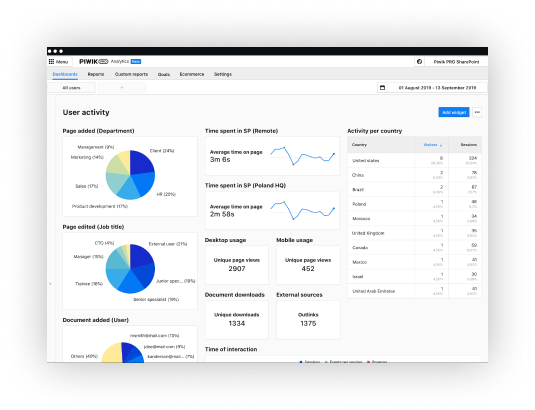Blog
The process of Marketing Analytics

What is Marketing Analytics?
Marketing Analytics is the measurement of marketing efforts that can be established through data gathered from marketing channels such as email marketing, social marketing, paid search etc. Marketing analytics aims to establish business metrics such as ROI (Return on Investment) and marketing attribution to sketch future marketing campaigns. The analytics job is to collect data from all the marketing channels, consolidate and combine it with the consumer database to give an insightful marketing view.

Steps to incorporate in your marketing analytics process:
-
Develop a plan to achieve your objective
Once your goal is defined, identify sources of data. Assess your website, email software and social media to determine engagement, response, click-through and unsubscribe rates. Ensure that roles are defined for the people involved and specify deadlines. Ensure there is open communication about progress.
-
Collect and combine data across departments
Pull data from multiple sources. Diversify your data pools. Data is collected, it needs to be combined and connected with other data sources within the firm. Connecting data brings accurate results than guess based historical data since various factors and price affect sales. This demonstrates the significant difference between empirical relationship and identity relationship. An empirical relationship implies a prediction, while an identity relationship is certain.
-
Build a professional analytics team
Build your marketing data team based on the type of your business and the amount of data and marketing technology. Your marketing data team must include marketing analysts, data scientists, developers, project manager, and marketing technologists. The entire analytic team needs to be placed in a separate department by the chief analytics officer (CAO).
-
Sketch rules and analytics techniques
The next step is to define metrics, strategies and technologies that you are going to use for analytics.
-
Identify data behind data - Use analytics to learn more about the consumer journey to build a better experience and improve retention.
-
Analyze historical data - Utilize marketing analytics to report past performance, which allows you to comprehend the trends. Identify the campaign that generated higher revenue in the previous year. Assess the performance of your email campaigns during the last year.
-
Engage with real-time - Marketing analytics platforms facilitate live feedback and ratings, which help you to comprehend the level of customer engagement with your offering, identify the channels that your most profitable consumers are engaging with. You will identify the customers who are talking about your products and services on social media with the help of the real-time feature of your marketing analytics platform.
-
Influence the future - The value of marketing analytics increases with data-driven predictions. Use analytics to build an effective marketing strategy for the upcoming year and design your campaign to convert short-term wins to ongoing engagement and loyalty. Use analytics to identify the markets that you should target next with the current portfolio. Identify the channels that are most effective for conversion.
-
Choose your model and reports - It is crucial to know which input of interest such as promotional pricing, seasonal, advertising and sales calls should be implemented to impact the dependent variable.
-
Build analytical strategy and actionable tasks - A marketing organization would need to plan a data-driven strategy that can obtain the most profitable results. It needs to develop a set of actionable tasks such as:
-
Set data collection - API's, tags, cookies, platforms
-
Build analytical models - Predictive, prescriptive, diagnostic, descriptive
-
Plan campaigns - Combine analysis and creativity to design effective campaigns
-
Visualization and storytelling - Interesting charts and dashboards
-
Optimize conversion - Testing UX, engagement and personalization
-
Design data-driven advertising - ROAS, bidding, targeting and budget allocation.
-
Analyze attribution - Channels optimization, top-down and bottom-up converge.
-
Research on tools - Develop marketing tech stack.
-
Learn from insights and optimize - Adjust strategies and tactics based on the insights provided by marketing analytics.
-
Measuring outcomes with the help of marketing analytics- Determine ROI for every marketing strategy. Marketing ROI can be calculated using the below formula:
Marketing ROI = [Incremental Sales x Gross Margin- Marketing Investment]
÷ Marketing Investment
CMO's can plan future campaigns based on the calculated ROI.
-
Utilization of results to make decisions - After the results are organized, and feedback from outside sources has been collected, determine if your original objective has been met. Continue to review and revise your marketing initiatives to meet and exceed your goal.
Benefits of Marketing Analytics
Analysis of marketing data plays a crucial role in achieving business objectives that could be strategic, financial or operational.
-
Comprehending your target consumer - helps you to analyze consumers, monitor consumer behaviour and predict purchasing trends.
-
Monitoring business goals - Combine offline data with online behaviour and measure customer lifetime value (CTV) and ROI.
-
Assessing your product's perception and advantages - To gather information about the product's perception and advantages, you need to engage potential and current customers through polls, surveys and direct conversations. It provides you with an insight into what sets your product apart and gives you an edge over the competition.
-
Learning customer's Ad preferences and trends - Different customer groups perceive marketing campaigns differently. This insight gives you an understanding of the way your consumers see your Ad messaging. It shows you the Ads that are converting and the Ads that your consumers tend to overlook. It will also illustrate the products your consumers opt to buy and the products that your customers are researching.
-
Identifying your customer's preferred media - Careful data analysis throws light on the preferred marketing channels your customers use. You will be able to identify the marketing channels that engage your target audience.
-
Evaluating marketing performance - Monitor real-time performance, campaign performance, return on Ad Spend (ROAS), forecast future performance, budget collection across devices and channels, and bidding strategy.
-
Studying the competition - Compare marketing efforts with competitors' marketing efforts. Monitor brand visibility and analyze market share.
-
Improving the marketing team - Build a data-driven marketing team, increase the efficiency of marketing priorities, ROI tracking, and enhance the credibility of results.
-
Predicting future results - You will design future campaigns by applying the knowledge from existing marketing campaigns that bring optimal results.
Challenges of Marketing Analytics
-
Quantity of data - Data gathered is enormous, and organizing and structuring data is time-consuming, and it is a cumbersome process. Marketers spend more time formatting and structuring data than spending time on analyzing the data.
-
Isolated environments - New technologies were deployed in remote environments, and the product was a massive set of platforms and tools of disconnected environments. Marketers have to implement various tools to monitor all the data sources such as Analytics tools, Social Media tools, SEO tools, Customer Relation Management (CRM) platform and Automation platforms.
-
Data discrepancies - Since different platforms are utilized for marketing, there will be mismatching results obtained from other platforms. Marketers are presented with the challenge of choosing the most reliable data source based on the data obtained from various sources.
-
Customization - Every business has its infrastructure and technology stack. Connecting sales data with online data is one of the challenges for marketers. Your company might be using salesforce for offline data and several tools for online data. Combining these two resources for analysis becomes expensive for SMEs (Small to Medium enterprise) who may not afford the cost of enterprise cloud or solutions.
-
Shortage of data scientists - Big data is available, but the challenge is to organize that data into utilizable formats. There is a scarcity of data scientists with the knowledge and skill to handle the process of organizing data.
-
Selecting the right attribution model - Attribution models help you make a connection between conversions and marketing channels. The focus of each attribution model is different. They provide insights that vary. Most companies own a marketing presence on several channels, and it is often difficult to choose the right attribution model.
-
Comparing data from disparate sources - Data from multiple marketing channels are dissimilar; hence it is difficult to correlate and compare this data. Marketers need premium marketing analytics software capable of gathering, combining and comparing enormous amounts of data.
Marketers depend on data to estimate their current marketing initiatives and analyze their value, significance and impact. Careful analysis of this data helps marketers identify which marketing efforts make the biggest difference and use that knowledge to modify current strategies and tactics and to eliminate poorly performing programs. They create new programs to engage their audiences better. When you study the insights provided by data and take responsive actions, you gain the competitive edge that you seek.